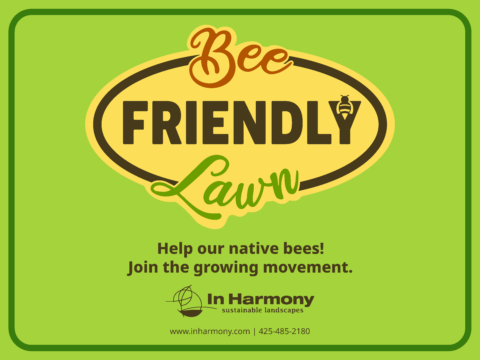 Earth Day was April 22, and April is Earth Month. Last week we suggested several ways to celebrate Earth Day, such as spending time outside and changing some of your daily choices.
Earth Day was April 22, and April is Earth Month. Last week we suggested several ways to celebrate Earth Day, such as spending time outside and changing some of your daily choices.
Here’s another great way to celebrate Earth Day and Earth Month: grow a Bee Friendly Lawn. We launched Bee Friendly Lawn last year to encourage our natural lawn care clients to join us in changing lawn care practices to protect our native bees as well as other beneficial insects and birds.
You may know that more than half the native bee species in North America are in decline. One in four species is at risk of extinction. Likely causes include habitat loss, heavy pesticide use, climate change and urbanization. More than 75 percent of flowering plants and crops rely on pollinators.
Bottom line: a healthy lawn is a Bee Friendly Lawn
Your lawn care practices can help—or harm—our native bees. Bottom line: to help save bees, keep your lawn healthy. A healthy, robust lawn is less likely to have problems with weeds, moss, disease and insects.
Focus on preventing problems now instead of using toxic products later. Proper lawn care will allow you to greatly reduce and perhaps eliminate the use of products such as herbicides, fungicides and insecticides.
In Harmony works in partnership with our clients to keep lawns healthy. Our natural lawn care services include fertilization, lime application, aeration and overseeding, and monitoring for potential problems.
Our clients are responsible for mowing and watering. Regular deep watering throughout the growing season and mowing higher are two key actions for a healthy lawn.
We will not use weed and moss killer on lawns that are not maintained properly. IPM (integrated pest management) guidelines say that pesticides should not be used without proper watering and mowing practices.
Here is an infographic that outlines key lawn care actions to support bee populations. We will provide more details on Bee Friendly Lawn Care practices over the course of the growing season. And you can find more details on our website.

Read more about native bees
Pollinators in Peril, Center for Biological Diversity.
Wild Bee Conservation, Xerces Society.
Disappearing Pollinators, Penn State Department of Entomology.
